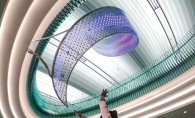How the individual players came to join Wild Prairie Brass in Edina is an exercise in six degrees of separation. The group’s website lists 16 other Twin Cities musical ensembles in which various Wild Prairie Brass players are also members, including the Lake Woebegone Brass Band, Minneapolis Brass and the First John Philip Sousa Memorial Band. Through their various professional and performance relationships, these musicians essentially have chosen each other for Wild Prairie Brass. “We all play for the love of the music,” says Mary Brindle, a horn player and member of Wild Prairie Brass who also serves on the Edina City Council and is an active community volunteer.
A brass choir, says Brindle, might have as few players as nine or as many as 14. Wild Prairie Brass consists of 11 musicians playing trumpet, flugelhorn (valved like a trumpet or cornet but with a mellower tone), French horn (also called simply “horn”), trombone, bass trombone, euphonium (also valved, resembling a small tuba with a tenor pitch), and tuba. You can find the biographies of all 11 current Wild Prairie Brass players on the group’s website. Occasionally, says Brindle, the group adds percussion, too.
If there is a budding composer in your house, he or she might like to meet Kelby Stine, a French horn player with Wild Prairie Brass. Stine has college degrees in music performance and composition and began composing music at age 13. By day, Stine works in music technology, but his first loves are composition, arrangement and a deeper understanding of performance practice. For Stine and his fellow musicians in the Wild Prairie Brass ensemble, one of the greatest joys of music-making is understanding how music was performed historically.
For example, Stine might enjoy telling you about Italian composer Giovanni Gabrieli (1554-1612), who was one of the first to write music specifically for brass choirs, and composed for early brass instruments that may or may not look like ours today, and (probably) sounded somewhat different. Early trumpets, for example, says Mary Brindle, had no valves.
When playing Gabrieli and compositions of similar vintage, says Stine, Wild Prairie Brass players must make decisions about style and sound that, even among music scholars, are open “to wild criticism and debate.” Dynamics, which is how loud or softly a note (or notes) are played, is one example. Written notation of dynamics—how loud the composer intended the notes to be played—didn’t exist until Gabrieli. “Modern audiences are used to a large range of volume,” says Stine. “Listeners 400 years ago would likely have heard a much smaller range.”
The Wild Prairie repertoire is varied enough to please just about any listener. Performances include early music, contemporary compositions, jazz and even a little rock and roll. Other performed works are by Dmitri Shostakovich, who wrote music for brass choirs, and Eric Ewazen, a contemporary American composer from the Juilliard School for Performing Arts. Wild Prairie Brass has even played a piece called “Quidditch,” from the Harry Potter movie franchise, arranged for brass choir by film score composer John Williams.
Wild Prairie Brass performances are generally informal. The choir has played in many senior communities, including the Waters of Edina and the Como Park Pavilion in St. Paul. Check the website for upcoming performances.









